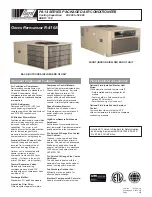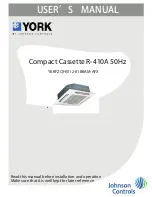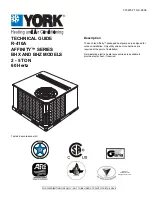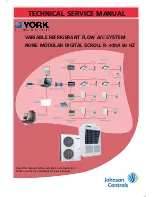
1--4
©
2012 Mobile Climate Control
T-353 Rev. 01/2013
Low Pressure Switch (LPS)
The low pressure switch is installed in the evaporator
section and opens on a pressure drop to shut down
the system when a low pressure condition occurs.
b. Fuses and Circuit Breakers
The Relay Board is protected against high current by
an OEM supplied circuit breaker or fuse located in
the bus battery compartment (150 Amp for 12 VDC
systems). Independent 20 Amp, 12 VDC fuses
protect each condenser motor. Independent 25
Amp, 12 VDC fuses protect each evaporator motor.
Output circuits are protected by additional 2,3,5 and
10 Amp fuses according to circuit loads. During a
high current condition, the fuse may open.
1.6 AIR CONDITIONING REFRIGERATION CYCLE
When air conditioning (cooling) is selected by the
controller, the unit operates as a vapor compression
system using R-134a as a refrigerant (See Figure 1-2
refrigerant flow diagram). The main components of
the system are the A/C compressor, air-cooled
condenser coils, receiver, filter-drier, thermostatic
expansion valve, liquid line solenoid valve (if
equipped), and evaporator coils.
The compressor raises the pressure and the
temperature of the refrigerant and forces it into the
condenser tubes. The condenser fan circulates
surrounding air (which is at a temperature lower than
the refrigerant) over the outside of the condenser
tubes. Heat transfer is established from the
refrigerant (inside the tubes) to the condenser air
(flowing over the tubes). The condenser tubes have
fins designed to improve the transfer of heat from
the refrigerant gas to the air; this removal of heat
causes the refrigerant to liquefy, thus liquid
refrigerant leaves the condenser and flows to the
receiver.
The refrigerant leaves the receiver and passes
through the receiver outlet/service valve, through a
filter-drier where a desiccant keeps the refrigerant
clean and dry.
From the filter-drier, the liquid refrigerant then flows
through the liquid line to the sight-glass and then to
the thermostatic expansion valve. The thermal
expansion valve reduces pressure and temperature of
the liquid and meters the flow of liquid refrigerant to
the evaporator to obtain maximum use of the
evaporator heat transfer surface.
The low pressure, low temperature liquid that flows
into the evaporator tubes is colder than the air that is
circulated over the evaporator tubes by the
evaporator fans (fans). Heat transfer is established
from the evaporator air (flowing over the tubes) to
the refrigerant (flowing inside the tubes). The
evaporator tubes have aluminum fins to increase
heat transfer from the air to the refrigerant; therefore
the cooler air is circulated to the interior of the bus.
The transfer of heat from the air to the low
temperature liquid refrigerant in the evaporator
causes the liquid to vaporize. This low temperature,
low pressure vapor passes through the suction line
and returns to the compressor where the cycle
repeats.
1.7 HEATING CYCLE
Heating circuit (See Figure 1-2) components
furnished by Mobile Climate Control include the
heater cores and solenoid operated heat valves.
Components furnished by the bus manufacturer
may include a water temperature switch (WTS) and
boost water pump.
The controller automatically controls the heat valves
during the heating mode to maintain required
temperatures inside the bus. Engine coolant (glycol
solution) is circulated through the heating circuit by
the engine and an auxiliary boost water pump. When
the heat valve solenoids are energized, the valves will
open to allow engine coolant to flow through the
heater coils. The valves are normally closed so that if
a failure occurs, the system will be able to cool.
Summary of Contents for 68AC430-100
Page 1: ...OPERATION SERVICE for 68AC430 100 REV 01 2013 T 353 Manual T 353 2012 Mobile Climate Control...
Page 30: ...5 2 2012 Mobile Climate Control T 353 Rev 01 2013 98 67037 00 Figure 5 2 Evaporator Motors...
Page 31: ...5 3 2012 Mobile Climate Control T 353 Rev 01 2013 98 67037 00 Figure 5 3 Condenser Motors...
Page 33: ...5 5 2012 Mobile Climate Control T 353 Rev 01 2013 98 67037 00 Figure 5 5 BT324 Control Circuit...











































